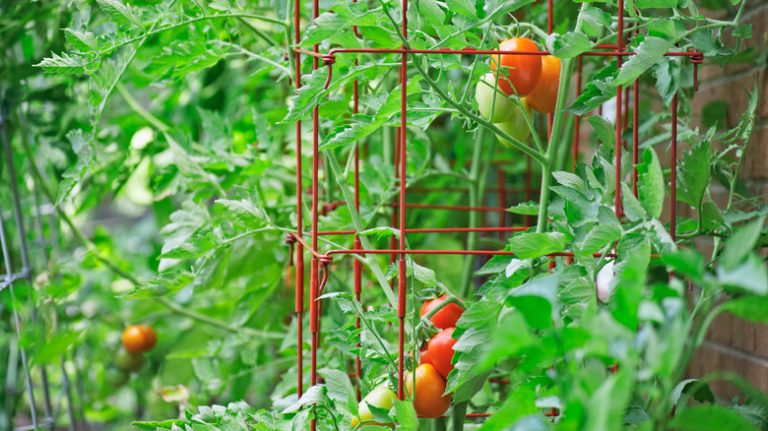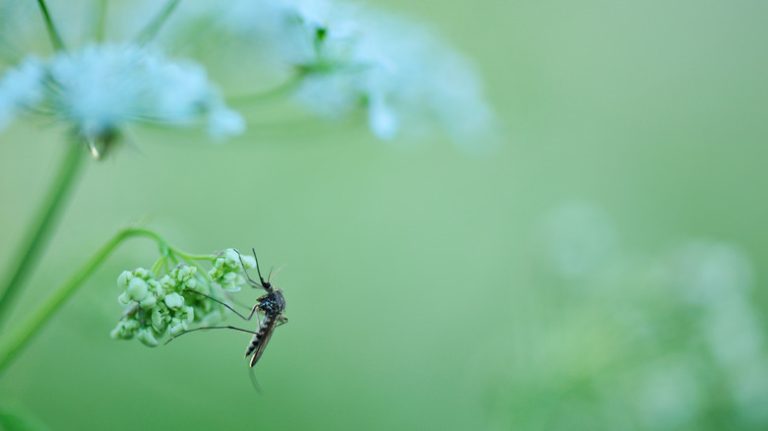Weeds are a common enemy of gardeners everywhere, but you don’t necessarily have to use chemical-laden herbicides to eliminate them. Instead, you have a whole arsenal of weed-fighting possibilities right in your kitchen cupboards. This veers from the traditional gardening advice or praise for chemical-based herbicides, and instead focuses on using everyday staples — like salt, vinegar, or coffee grounds — to rid your lawn or garden of pesky weeds.
As a bonus, these ingredients are typically readily available and give you much gentler alternatives to chemical options. However, there are still things to consider. Each ingredient works differently, whether you harness vinegar’s acidity to burn through the weeds, dehydrate them with salt, or use coffee grounds to slow their growth. Knowing the application that goes hand-in-hand with using these kitchen ingredients ensures your yard stays healthy. While these items give you a more eco-friendly option, you still have to be careful when applying them to avoid altering the soil or burning your plants. Here’s the lowdown on the kitchen ingredients that can help combat weeds in your lawn.
Vinegar burns weeds on contact
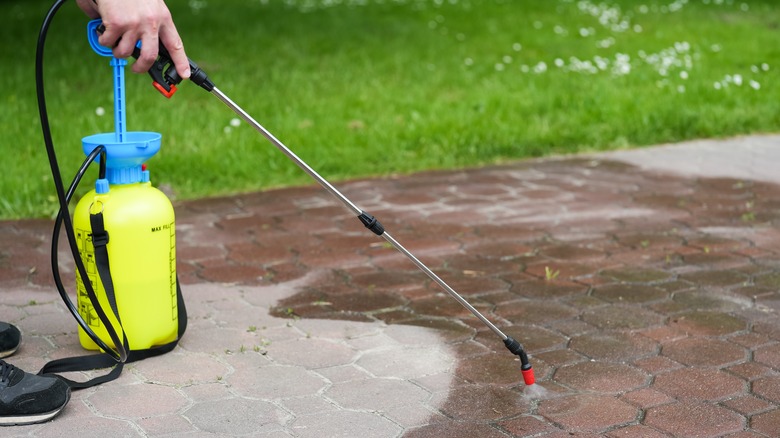
Vinegar is famous for culinary use, but is also a very effective herbicide because it contains acetic acid. To control young weeds under two weeks old, pick a vinegar with a higher acetic acid content, ideally between 10% and 20%, like a horticultural vinegar. This stronger acetic acid concentration is much more effective against weeds than standard white vinegar. Directly spray or pour the vinegar onto the weeds, ensuring you cover them completely, as the vinegar will only kill what it touches. Wait to apply it until it’s sunny and calm out. This prevents drifts and allows the vinegar to come into solid contact with the weeds.
It’s the vinegar’s acetic acid content that kills the weeds. Montana State University explains that it does so by getting into the weed cell walls, causing them to rupture, therefore dehydrating the plant tissues. This works very well on annual, young weeds, as they’re much less resistant to acetic acid. It acts fast, and you can see results in as little as 24 hours. However, when you treat weeds around plants or flowers you want to keep alive, use a precision spray applicator or shield to avoid accidentally getting the vinegar on them. Vinegar is non-selective, and it’ll kill whatever it lands on. Also, older weeds will need a higher acetic acid concentration to kill them effectively.
Table or rock salt dehydrates weeds
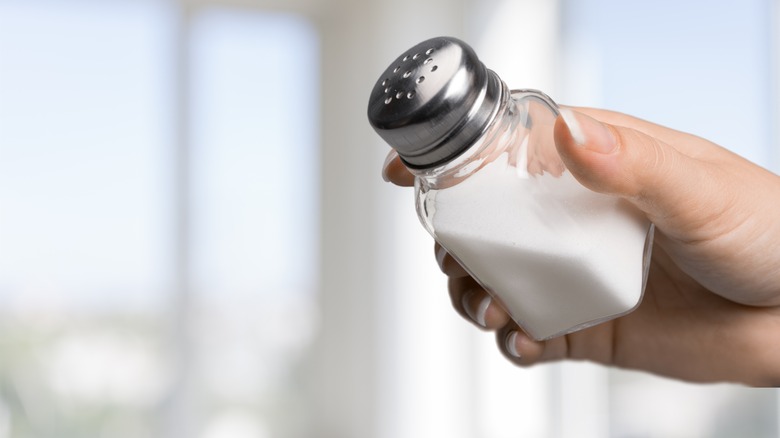
Table or rock salt is a kitchen staple that has been used to grow better tomatoes and to de-ice things in winter — and now you can add killing weeds by dehydrating them to the list. Sprinkle salt directly onto the weed leaves or at the weed’s base for it to work. Another option is to dissolve it in water to make it more manageable. For the saltwater solution, mix eight parts hot water with one part salt and stir until the salt dissolves. Apply it directly to the weeds. This method works very well for spot treatments on patios, driveways, or paths where weeds poke through the cracks.
Salt is a weed dehydrator using osmosis. Adding a high salt concentration to the weed’s exterior pulls water from its cells, causing it to dehydrate and die. Salt uses the weed’s ability to retain moisture for this process. It’s very fast-acting and ensures that the weed can’t recover, because the salt left in the soil affects the growth environment. It works well for spaces where traditional weed control isn’t possible. But UC Weed Science points out that overusing or misapplication can result in salty soil that is too hostile for some plants to grow. It also can’t distinguish between weeds and good plants or flowers, so apply it carefully for the best results.
Baking soda is a natural herbicide
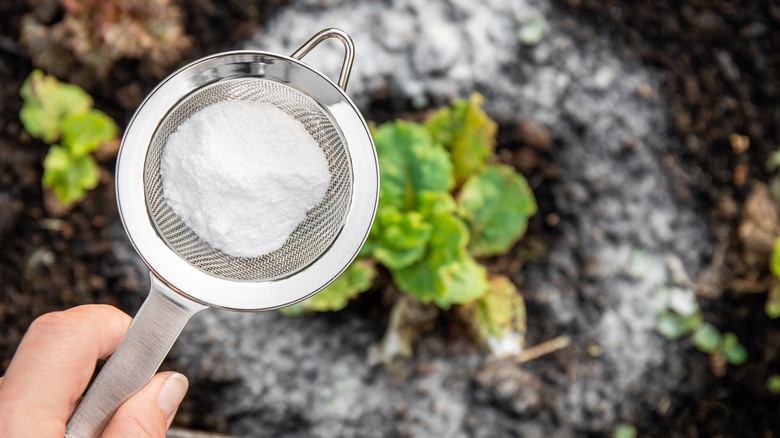
FotoHelin/Shutterstock
Almost everyone has baking soda stashed away in their kitchen, and luckily it makes an excellent natural herbicide that helps manage weeds in your paths, garden, or patios. Sprinkle a generous coating onto the weed’s foliage and the soil around the base. For a more targeted application, put 1 ½ cups of baking soda into a gallon of water and spray it directly onto the weeds. Adding a tablespoon of vinegar makes it more potent for stubborn weeds. Reapplying it every few weeks helps manage weed growth.
Baking soda is a natural herbicide, creating an environment where weeds have trouble growing. When it sticks to the weeds, it works like a desiccant, pulling moisture out of the plant cells to dehydrate them. This water balance disruption causes weeds to wilt and die. The sodium bicarbonate content also disrupts the pH balance in the soil, making it hard for weeks to thrive. As a bonus, baking soda is non-toxic to use around pets and kids.
While baking soda is a practice weed controller, Atlas Scientific points out that using it dramatically increases the soil’s alkalinity. This pH change can damage acid-loving plants and reduce how much nutrients are available in the soil, stunting your plant’s growth. Therefore, monitor the pH levels and only use it sparingly.
Boiling water cooks the weeds on contact
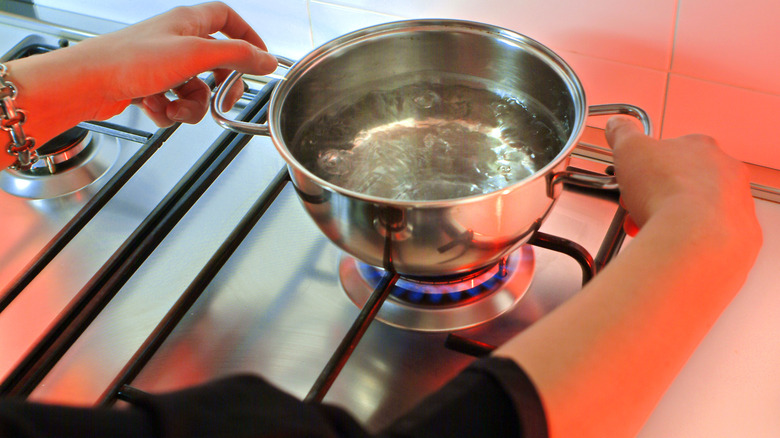
Luigi Bertello/Shutterstock
Boiling water is a simple, immediate weed control method that uses high temperatures to scald the weeds. Heat water to a boil and carefully pour it onto any weeds you want to kill. For the best results, pour the boiling water directly over the weed’s leaves and crowns, because this targets the plant’s most vital areas for the biggest impact.
Boiling water kills weeds because it can cause severe and immediate damage to the weed’s structure. The extreme heat of the boiling water destroys the plant’s cells by causing their walls to burst and changes the structure of essential proteins, just like when you cook. This quick thermal shock stops the plant from maintaining its structural integrity, and it dies as a result. It’s a fast method that shows results within 24 hours, doesn’t add chemicals to the garden, and is eco-friendly.
While the scalding water kills any parts of the weeds it lands on, it may not reach or kill the root system, especially with perennial weeds with deep roots. So, the weeds could come back, meaning you have to treat them again. Also, boiling water is a non-selective herbicide, so it’ll kill almost any plant it lands on, making it a solid option for spot treatment applications.
Rubbing alcohol dehydrates weeds
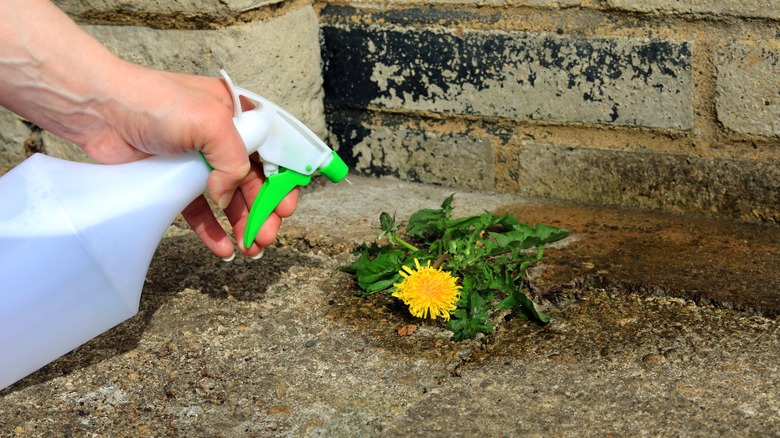
Dean Clarke/Shutterstock
Have you ever thought about using rubbing alcohol to destroy weeds? If not, you definitely should. Just mix 2 tablespoons of rubbing alcohol and 4 cups of water in a spray bottle. Shake and spray it directly onto the weed leaves during the sunniest part of the day. The alcohol will sink into the weeds quickly, so applying it when sunny ensures it evaporates quickly to reduce harming nearby flowers, grass, or plants.
Rubbing alcohol uses dehydration to kill weeds. When you apply it, it starts breaking down the weed’s outer protective layer, causing quick water loss. Osmosis, where water moves from an area of low solute concentration to one with high solute concentration, gets disrupted. As a result, the cells lose water very fast. The evaporation rate means it works quickly, killing the weeds within a few days without leaving soil residue. Rubbing alcohol’s ability to disrupt the weed’s cellular structures at contact ensures it works on a broad range of weeds.
However, rubbing alcohol will harm any plant it lands on. Use it carefully and avoid spraying it on windy days to prevent it from drifting to your non-weed plants or lawn. Also, it can dry out the soil in that particular area, so don’t overdo it.
Dish soap breaks down the weed’s outer layer
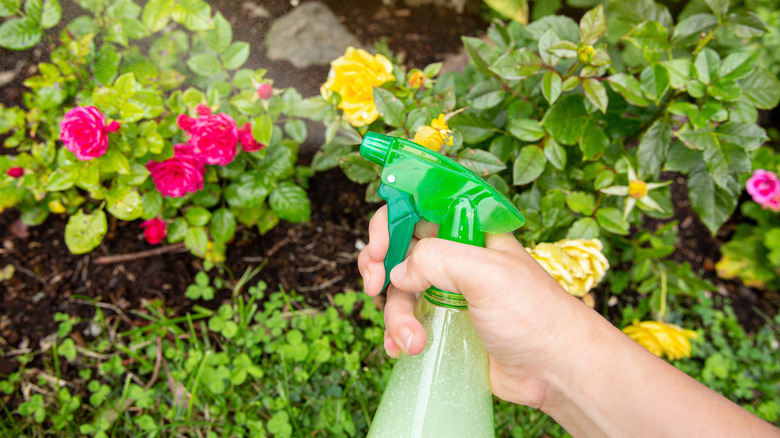
FotoHelin/Shutterstock
Dish soap is a common cleaning agent that helps manage weeds. Mix a teaspoon of dish soap into a quart of water in a spray bottle. Shake to dissolve the soap and spray it right onto the weed stems and leaves. It’s recommended that you apply it during the early morning or afternoon when the sun isn’t as intense. This gives you the best results, because the solution sticks to the weeds longer without drying out.
Dish soap is an effective weed killer because it breaks down the plant’s protective outer layer. Its surfactant property reduces water’s surface tension, letting it get into the weed’s foliage better. Spraying it on the weeds strips away the protective, waxy outer coating, allowing them to dehydrate. Without the protective layer, the weeds lose water quickly and can’t stay hydrated enough to keep their cellular functions going, resulting in death. This method is helpful because it targets the weed’s physical defense mechanism. However, dish soap works better on immature, smaller weeds than established ones. The younger weeds are more vulnerable to the soap’s effects, making it critical you spray them early to make it effective.
Lemon juice burns and kills weeds

Fotostorm/Getty Images
Lemon juice’s natural acidity is an eco-friendly and effective way to kill weeds. Use fresh or concentrated lemon juice and apply it directly to the weeds you want to kill, focusing on the leaves and stems. For a broader application, mix one part lemon juice with two parts water. The University of Tennessee says this will kill 80% to 100% of the top growth, showing results in as little as two hours. It works wonderfully for spot treatments in gardens, yards, patios, or walkways where weeds have sprung up.
The higher citric acid content is why lemon juice excels at killing weeds, as it scalds the outer layer, making photosynthesis impossible and leading to dehydration and death. The acid attacks the weed’s cell walls, making them lose moisture, wilt, and die. The most significant consideration when you use lemon juice to control weeds is that it can lower the sol’s pH levels, making it very acidic. Altering the soil’s chemistry can damage certain plants and impact the soil’s health, making it impossible for some plants to grow. So, be very cautious when you use it and monitor your soil’s acidity levels, especially for repeat treatments. The soil conditions and weed type also factor into how successful this method is.
Borax is toxic to weeds
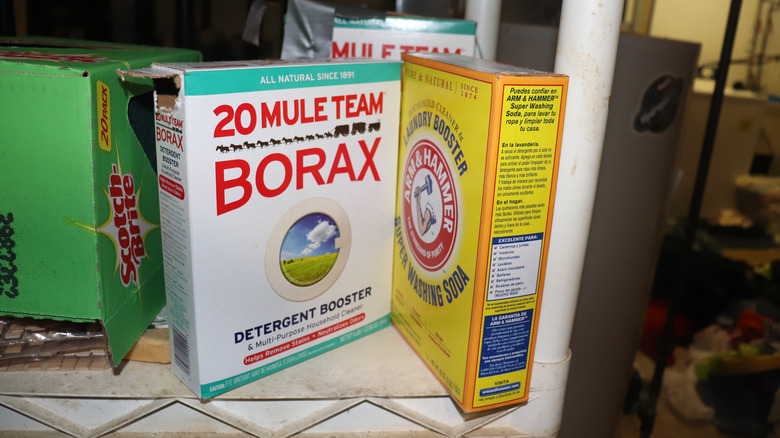
Eleanor McDonie/Shutterstock
Borax is a standard household cleaner that effectively controls weeds if you use it correctly. To use borax against weeds, mix 5 teaspoons of borax into a quart of water, stirring until the borax dissolves. Apply it sparingly to the weed leaves and stems, using a watering can for broader applications, or a spray bottle to be more precise. Wait for dry weather to apply it so it sticks to the weeds and has time to work before rain washes it away.
The Yellow Farmhouse Garden points out that it’s an effective weed killer due to the boron content, as this is a trace mineral that can be toxic to plants in large quantities. Applying it to weeds disrupts their cellular integrity and slows their growth, killing them. This is especially effective because it targets the weed’s physiological mechanism, stopping it from performing essential functions like nutrient absorption and photosynthesis.
However, misusing borax leads to soil toxicity, damaging plants you want to keep. Soil with too much borax is incapable of supporting healthy plant growth. So, apply it in small-scale, measured applications, and focus only on areas where you want to control weeds.
Cinnamon inhibits weed growth
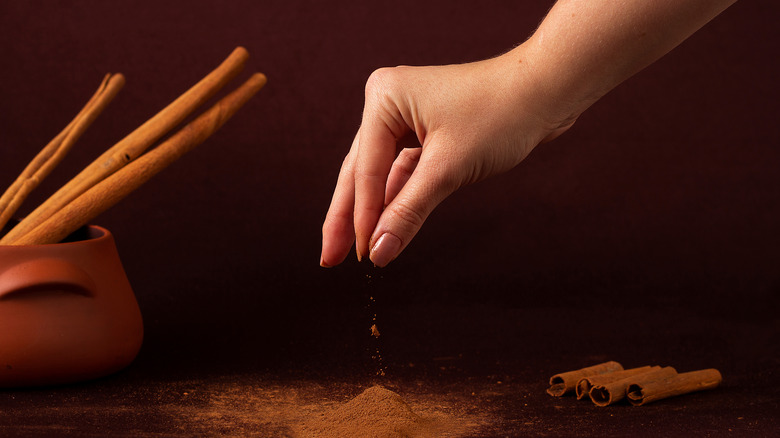
Steph Mattioli/Shutterstock
Sprinkle ground cinnamon over any spots where weed control is an issue, or dilute cinnamon oil with water and spray it on the weeds instead. You can apply it directly to the soil’s surface around your plants, grass, and flowers to inhibit weed growth. A sieve or handheld spreader ensures you get an even application with ground cinnamon. It’s best to use this method early in the growing season or right after you weed to prevent new weeds from popping up.
Cinnamon’s natural chemical compounds slow and stop young weed plants from germinating. They do so by disrupting the cellular processes the weeds need to sprout and grow, and applying it to the soil makes it hard for weeds to germinate. Molecular Diversity Preservation International also points out that you can use it to ward away garden pests and keep your plants healthy. Apply the cinnamon evenly and sparingly, focusing on the areas directly around the weeds, especially in flower beds or vegetable gardens where you have plants you actually want to do well. This targeted approach helps preserve the beneficial qualities of the soil, while leveraging cinnamon’s natural weed-suppressing properties.
Sugar slows weed growth
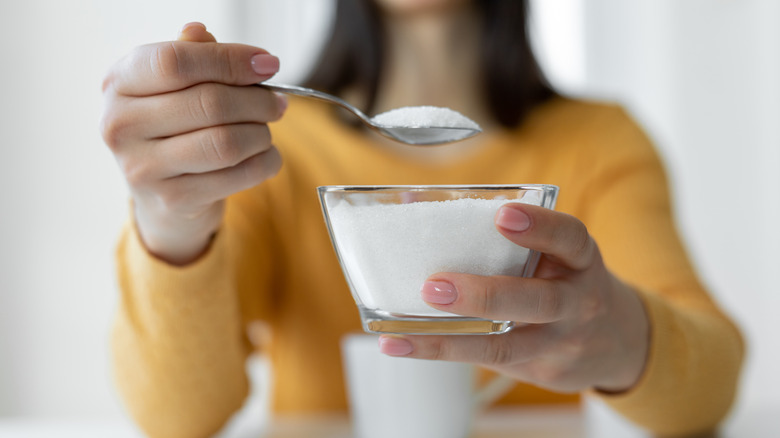
Bymuratdeniz/Getty Images
A simple sugar trick can rid your lawn of weeds by slowing their growth. Sprinkle the sugar directly onto the soil around the weeds or in spots where you have a weed problem, and lightly water the area to dissolve the sugar and help it penetrate the soil. This method works well when you use on weeds near established plants, because the sugar won’t hurt them.
Sugar slows down weed growth by disrupting the nutrient balance in the soil. Sugar boosts the microbial activity in the soil, causing nitrogen to drop, a crucial nutrient weeds use to grow, according to restoration ecologist Alexi Gilchrist (via ABC Australia). With lower nitrogen levels, weeds struggle to grow, multiply, and absorb nutrients, creating a sterile environment. Also, the increased antimicrobial activity can benefit the soil’s health in the long run if you use it as part of a broader strategy to control weeds.
However, just using sugar might not be effective for controlling weed growth, and the method works better on annual and broadleaf weeds, rather than perennials. It’s common to use it alongside pulling or mulching weeds, and using too much causes soil imbalances and can attract pests, so apply it sparingly and lightly.
Chili pepper powder’s capsaicin destroys weeds
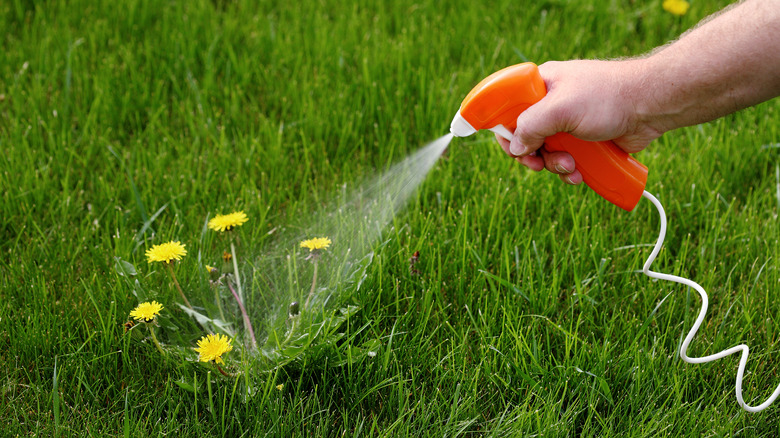
Brian Brown/Getty Images
Chili pepper powder is an effective weed control, and you use it by mixing a tablespoon of powder with 2 quarts of water. Pour it into a spray bottle and apply it directly to the weed stems and leaves, ensuring you soak them. It’s an excellent spot treatment for your lawn, in garden beds, along fence lines, or between patio pavers. Wait until a dry, calm day to apply it to prevent it from drifting to wanted plants or onto your skin.
The active component of chili pepper powder is capsaicin, the herbicidal agent. When you apply it, the capsaicin disrupts their cellular processes, stopping them from photosynthesizing and managing water, leading to death. It works well against tender, young weeds and gives you an organic and chemical-free way to control weed growth. You can apply it to established plants’ foliage to deter pests. However, since it’s so potent, be careful when you apply it. Wear gloves and protective eyewear if necessary to prevent skin and eye irritation. This is especially important when mixing and applying the solution to ensure safe and comfortable use.
Coffee grounds’ acidic nature inhibits weed growth
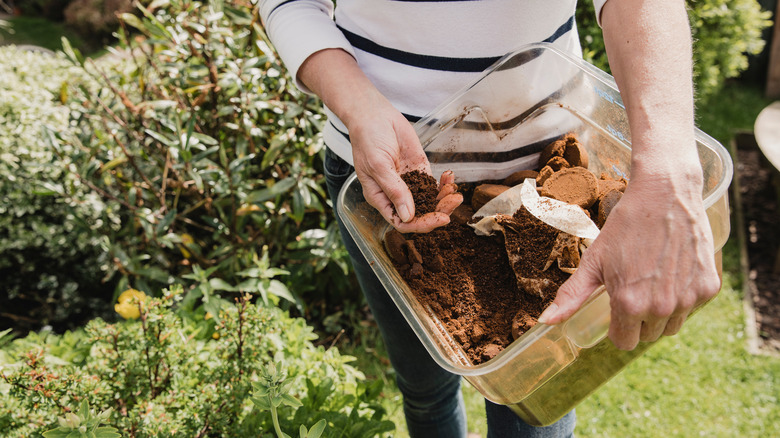
DGLimages/Shutterstock
Putting coffee grounds on your lawn helps control weeds. Scatter the grounds onto the soil around the plants. You can also mix the grounds into the top few inches of soil, and this is especially helpful in areas where you’re battling persistent weed issues or where you want to stop the weeds from taking hold. Placing a thin layer around the base of your plants prone to weed competition creates a barrier to suppress unwanted growth.
Coffee grounds are acidic and their nutrient content helps suppress weeds. The caffeine restricts weed seed growth and germination. Regularly applying coffee grounds in large amounts can cause the soil to be more acidic, which is suitable for acid-loving plants like rhododendrons, blueberries, and azaleas. However, it’s not good for plants that prefer alkaline or neutral soils. Monitor the pH levels and use your coffee grounds sparingly for the best results.
Hydrogen peroxide may oxidize weed cells
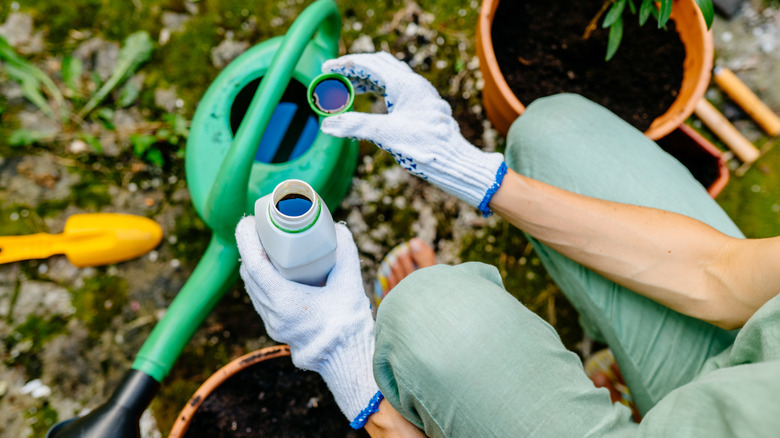
Iryna Inshyna/Shutterstock
Hydrogen peroxide is a common household disinfectant that can also manage weeds. To use it on your lawn, you’ll mix a solution of one part 3% hydrogen peroxide with six parts water. Pour it into a spray bottle and soak the weeds, aiming to coat the stems and foliage. Apply it during the late afternoon or early morning to maximize its effectiveness, while minimizing evaporation. Spraying at the base of the weeds helps get it to the roots, which will in turn kill the weeds quicker.
Hydrogen peroxide has oxidizing properties, and it penetrates the weed’s cells to cause oxidative stress when you apply it. This leads to cell damage and death by disrupting the normal function of the weed’s cells, slowing down their ability to reproduce and grow. What’s also great is that, because of how it breaks down, it will not leave a residue in the soil. However, be aware that there is minimal scientific research to support that hydrogen peroxide is an effective weed killer, and most support comes from anecdotal reports, like from The Dirt Doctor. It’s also essential to use this method carefully, because applying too much can harm the beneficial microorganisms in the soil.
Epsom salt and vinegar dehydrates weeds
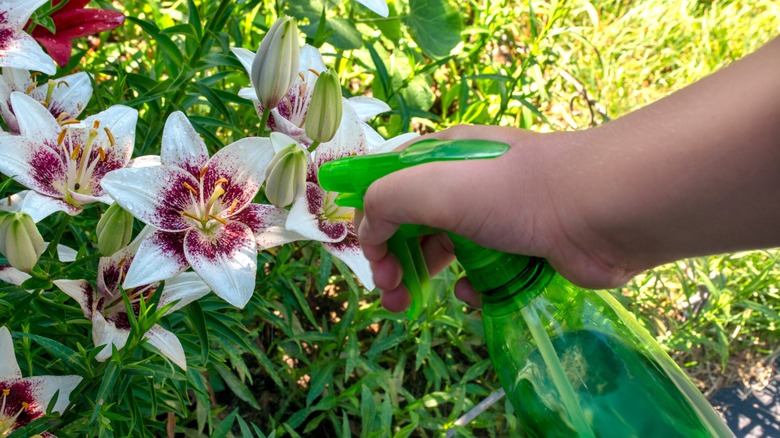
Ollphotograph/Shutterstock
Mixing Epsom salt and vinegar can kill weeds in your yard or garden. The Oregon State University recommends using a quart of vinegar with 20% acetic acid concentration to be as effective as possible. Add ½ cup of Epsom salts with a tablespoon of liquid dish soap and pour it into a spray bottle. Coat any weeds you want to remove, dousing the stems and leaves. Apply it on a sunny day to enhance dehydration.
Due to their respective properties, vinegar and Epsom salt work to dehydrate and kill weeds. Vinegar has acetic acid that lowers the pH levels on the weed’s surface, making it dry out. Epsom salt is a desiccant that draws out moisture from inside the weed. Combined, they disrupt the natural water balance in the weed, making it dehydrate very quickly and die. Adding liquid dish soap makes the solution stick to the weed better, making it more effective.
However, while vinegar and Epsom salt effectively kill weeds, they’re also non-selective and will damage any plants they land on. Repeatedly using it also causes salt to build up in the soil, damaging its structure and fertility. This is why applying this solution carefully is crucial, using targeted applications to avoid affecting desirable plants. It’s also smart to monitor soil health to prevent salt accumulation.

